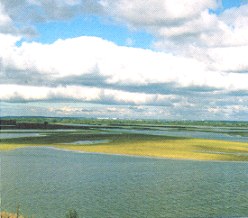Economy > Natural Resources
Natural Resources
 | |
Along with crude oil, bradenhead gas is extracted in the amount of about 40 cu. m per ton of oil. There are good outlooks for involvement of natural bitumens into the economic turnover, since estimated reserves in the territory of the Republic make up 12.5 bln. t.
Among other fuel resources, Tatarstan possesses brown and black coal, combustible slates and peat. There are about 800 peat deposits with overall square of more than 35,000 hectares. In the territory of eastern regions the large coal deposits were discovered, but their industrial development is complicated by deepness of their occurrence. Reserves of combustible slates are available in the south-western part of the Republic. They can be of industrial importance in prospect.
 | |
Tatarstan, as no other republic or region, is rich in rivers. There are numerous lakes and underground waters. As noted above, the biggest rivers of the Republic are the Volga and the Kama and two confluents of the Kama river - the Vyatka and the Belaya. The annual flow of the four rivers makes 234 bln. cu.m per year. Besides, there are about 500 small rivers with length no less than 10 km and numerous brooks. Huge water resources are accumulated in two biggest reservoirs - the Kuibyshevskoye and the Nizhnekamskoye. There are also over 8,000 small lakes and ponds in the Republic. The Republic has substantial reserves of underground waters varying from highly mineralised water to slightly salted and fresh.